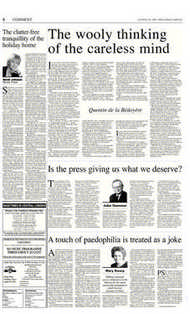Page 10, 20th August 2004
Page 10

Report an error
Noticed an error on this page?If you've noticed an error in this article please click here to report it.
Tags
Share
Related articles
A Play That Isn't A Play
Theatre
Long Stay In Camelot
Pastures New At Last For 'my Fair Lady'
A Supercalifragilisticexpialdocious Magic
‘My Fair Lady’ watered-down
My Fair Lady was one of the great musicals of the 1950s and expectations, in 1960, for Alan Jay Lerner and Frederick Loewe’s new show, Camelot, were high. It had the same star (Julie Andrews), the same director (Moss Hart), the same designer (Oliver Smith), the same choreographer, (Hanya Holm), and the same comedian (Robert Coote).
Camelot did not have an easy ride. On the opening night of its previews in Toronto the show lasted four hours. Loewe had a bleeding ulcer and Hart had a heartattack from which he never fully recovered. When the production finally opened on Broadway everybody agreed it wasn't as good as My Fair Lady, but thanks to advance sales, it ran for 873 performances. Camelot was the most expensive show ever produced on Broadway. It was like watching a gigantic mannequin parade. It was of this musical that it was first said that audiences came out of the theatre singing the costumes and scenery. Ian Talbot’s modest revival in the Open Air Theatre, Regent’s Park, is a pleasant way to spend a balmy summer’s evening.
The passion between Guinevere and Lancelot is absolutely chaste. Adultery takes place only in their minds. The source for this version is not Thomas Malory, nor Alfred Lord Tennyson, but T H White’s whimsical The Once and Future King. The deliberate anachronisms cheapen a great love story. The jokes would be more appropriate in Rodgers and Hart’s musical adaptation of Mark Twain’s A Connecticut Yankee in King Arthur’s Court.
Camelot feels like a watered-down My Fair Lady. King Arthur (a role for a nonsinging actor, created by Richard Burton in New York, played by Laurence Harvey in London and by Richard Harris on film) sounds like Professor Higgins when he talks his way through How To Handle A Woman, a reprise of Why Can’t A Woman Be Like A Man? The jousting off-stage replicates the horse-racing offstage at Ascot. A squirmmaking number like The Merry Month of May makes many people long for June.
The ending, however, is superb. The final chorus gives the musical an unexpected dignity and tragic strength. Camelot was President John F Kennedy’s favourite musical.
On the night of his assassination it was reported that the entire theatre audience cried out in a collective howl of grief when they heard the last lines of the last song: “Don’t let it be forgot/That once there was a spot/For one brief shining moment that was known as/Camelot.”
Singin’in the Rain is one of the best-loved film musicals of all time yet all attempts to repeat its success on stage have failed. Jude Kelly, at The National Theatre, made a splash in 2000 when audiences sitting in the front rows were drenched by the cast stamping in puddles of water. The
drenching was the high spot – especially for those not getting drenched. Why bother to stage a classic film when Gene Kelly himself said the whole point of the 1952 film had been that he “was desperate to do things on the screen that simply could not be done in the theatre”?
It is difficult to see how any actor-dancer would be able to compete with the memories of Kelly’s performance. Adam Cooper, former Royal Ballet dancer, brilliant as the Swan in Matthew Bourne’s all-male Swan Lake, has been trying to make the transition from ballet to musical. What he probably needs is another Matthew Bourne vehicle, something along the lines of Play Without Words. In the Gene Kelly role Cooper is a big disappointment as an actor, as a singer and as a comedian. He is upstaged by Simon Coulthard in the Donald O’Connor role and Coulthard doesn’t begin to have Donald O’Connor’s vaudeville virtuosity. Cooper is also responsible for the lacklustre choreography. Paul Kerryson’s production is well below his standard. The funniest bits are the film clips showing silent movie stars coping with the advent of sound, but the joke is dreadfully laboured and amateurishly performed.
Camelot is at Open Air Theatre, Regent’s Park until September 4. Singin’in the Rain is at Sadler’s Wells until September 4, and then at Haymarket Theatre, Leicester.
Robert Tanitch
blog comments powered by Disqus















